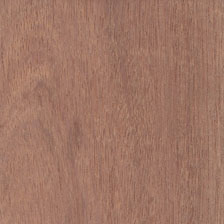Sapele

Other names
Assie, Sapelli
Scientific Name
Entandrophragma cylindricum
Family
Meliaceae
Description
Medium to dark reddish brown or purplish brown. Color tends to darken with age. Besides the common ribbon pattern seen on quartersawn boards, Sapele is also known for a wide variety of other figured grain patterns, such as: pomelle, quilted, mottled, wavy, beeswing, and fiddleback. Grain is interlocked, and sometimes wavy. Sapele has a fine texure and small pores. The wood has a distinct cedar-like smell.
Density
(H=12%) : 0,68
Treatability
Poorly permeable
Seasoning
It air dries fairly rapidly, but is liable to warping and distortion.
Stability
Moderately stable
Durability
Moderately durable to very durable in regard to decay resistance.
Workability
The wood saws and works easily with both hand and machine tools; it has only slight blunting effects on cutting edges. In planing and moulding operations, a 15–20° cutting angle is recommended to avoid picking up of grain. Finishing gives usually good results, with a nice polish. The wood is not liable to splitting in nailing and screwing, with good holding properties. The gluing, staining and polishing properties are good, but the steam bending properties are poor.
End-Uses
- Sliced veneer
- Cabinetwork (high class furniture)
- Current furniture or furniture components
- Exterior joinery
- Interior joinery
- Interior panelling
- Veneer for interior of plywood
- Veneer for back or face of plywood
- Flooring
- Stairs (inside)
- Ship building (planking and deck)
- Light carpentry
Notes : Good Substitute to African Mahogany.
Download the complete data sheet